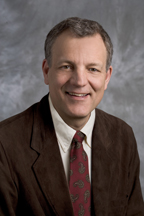What do the crew of an airliner and an operating room team have in common? Whether you’re in the air or in the operating room, your life is in their hands.
The parallel is too real to ignore. That’s why The Nebraska Medical Center is taking the lead in bringing patient safety to a new high. The cutting edge procedures and technology for which the hospital is known will soon be further enhanced by the same crew resource management (CRM) techniques used in the aviation industry.
 |
Stephen Smith, M.D. |
The system was developed more than 25 years ago by the aviation industry. At that time, the majority of airline accidents were caused by failures in communication among crew members. Airlines discovered a distinct improvement when flight crews were taught how to communicate more effectively. The program is now filtering into the world of medicine with the nation’s top hospitals leading the way.
Surgeons, anesthesiology team members, residents, nurses and support staff at The Nebraska Medical Center and UNMC will receive training from the “LifeWings” group, experts in crew resource management. Three OR teams – orthopedic surgery, oral and maxillofacial surgery and cardiovascular surgery – will be the first to go through training beginning in late February. Other teams will follow.
 |
Byers Shaw Jr., M.D. |
Before the introduction of crew resource management, airline crew members all too often viewed the captain as supreme commander, someone whose decisions or judgments were not to be challenged. “Under crew resource management, the surgeon is still captain of the ship,” Dr. Shaw said. “But that captain openly invites, in fact, expects the other members of the crew to speak up whenever they notice something that appears unusual or out of place.”
Said Shelly Schwedhelm, R.N., director of Perioperative Services at The Nebraska Medical Center: “The use of CRM creates an atmosphere of mutual responsibility not only for making sure everyone does his or her job, but also for making sure everyone else on the team is informed. By replacing guessing and assumption with clear communication techniques, CRM enhances safety and optimizes clinical performance.”
 |
Shelly Schwedhelm |
Crew resource management also emphasizes the need for standardization through pre-surgical routines and the use of checklists, some elements already in use at The Nebraska Medical Center.
It sounds a lot like common sense, but as Dr. Shaw points out, the overall effect goes much deeper. “In aviation the use of crew resource management techniques clearly defined everyone’s roles and responsibilities,” he said.
“This is a natural step in our evolution of patient safety,” Dr. Smith said. “It’s one of the most ambitious proactive projects we’ve undertaken.”
As a teaching hospital, The Nebraska Medical Center, together with UNMC, has a unique opportunity to impact the future of crew resource management. Residents will learn the program from day one, allowing it to become ingrained in the medical culture. “For the next generation of medical professionals, this will become their routine, the way they do business,” Dr. Shaw said.
Less than 10 percent of hospitals nationwide are currently using the system. The Nebraska Medical Center is one of the first in the Midwest to begin implementation.